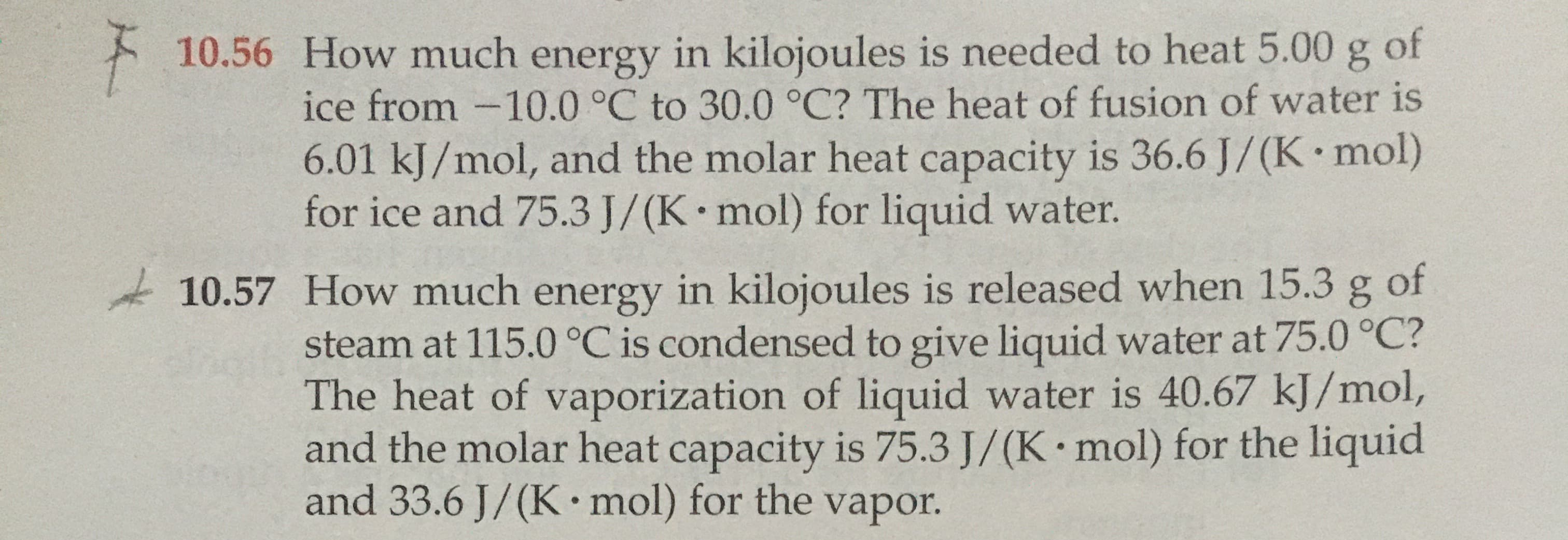10.56 How much energy in kilojoules is needed to heat 5.00 g of ice from -10.0 °C to 30.0 °C? The heat of fusion of water is 6.01 kJ/mol, and the molar heat capacity is 36.6 J/(K mol) for ice and 75.3 J/(K mol) for liquid water. 10.57 How much energy in kilojoules is released when 15.3 g of steam at 115.0 °C is condensed to give liquid water at 75.0 °C? The heat of vaporization of liquid water is 40.67 kJ/mol, and the molar heat capacity is 75.3 J/(K mol) for the liquid and 33.6 J/(K•mol) for the vapor.
10.56 How much energy in kilojoules is needed to heat 5.00 g of ice from -10.0 °C to 30.0 °C? The heat of fusion of water is 6.01 kJ/mol, and the molar heat capacity is 36.6 J/(K mol) for ice and 75.3 J/(K mol) for liquid water. 10.57 How much energy in kilojoules is released when 15.3 g of steam at 115.0 °C is condensed to give liquid water at 75.0 °C? The heat of vaporization of liquid water is 40.67 kJ/mol, and the molar heat capacity is 75.3 J/(K mol) for the liquid and 33.6 J/(K•mol) for the vapor.
Chemistry & Chemical Reactivity
9th Edition
ISBN:9781133949640
Author:John C. Kotz, Paul M. Treichel, John Townsend, David Treichel
Publisher:John C. Kotz, Paul M. Treichel, John Townsend, David Treichel
Chapter12: The Solid State
Section: Chapter Questions
Problem 31PS: Benzene, C6H6, is an organic liquid that freezes at 5.5 C (Figure 11.1) to form beautiful,...
Related questions
Question
Can you please solve these two sub problems and show the step by step to the solution please

Transcribed Image Text:10.56 How much energy in kilojoules is needed to heat 5.00 g of
ice from -10.0 °C to 30.0 °C? The heat of fusion of water is
6.01 kJ/mol, and the molar heat capacity is 36.6 J/(K mol)
for ice and 75.3 J/(K mol) for liquid water.
10.57 How much energy in kilojoules is released when 15.3 g of
steam at 115.0 °C is condensed to give liquid water at 75.0 °C?
The heat of vaporization of liquid water is 40.67 kJ/mol,
and the molar heat capacity is 75.3 J/(K mol) for the liquid
and 33.6 J/(K•mol) for the vapor.
Expert Solution
This question has been solved!
Explore an expertly crafted, step-by-step solution for a thorough understanding of key concepts.
This is a popular solution!
Trending now
This is a popular solution!
Step by step
Solved in 8 steps with 8 images

Knowledge Booster
Learn more about
Need a deep-dive on the concept behind this application? Look no further. Learn more about this topic, chemistry and related others by exploring similar questions and additional content below.Recommended textbooks for you

Chemistry & Chemical Reactivity
Chemistry
ISBN:
9781133949640
Author:
John C. Kotz, Paul M. Treichel, John Townsend, David Treichel
Publisher:
Cengage Learning

Chemistry & Chemical Reactivity
Chemistry
ISBN:
9781337399074
Author:
John C. Kotz, Paul M. Treichel, John Townsend, David Treichel
Publisher:
Cengage Learning

General Chemistry - Standalone book (MindTap Cour…
Chemistry
ISBN:
9781305580343
Author:
Steven D. Gammon, Ebbing, Darrell Ebbing, Steven D., Darrell; Gammon, Darrell Ebbing; Steven D. Gammon, Darrell D.; Gammon, Ebbing; Steven D. Gammon; Darrell
Publisher:
Cengage Learning

Chemistry & Chemical Reactivity
Chemistry
ISBN:
9781133949640
Author:
John C. Kotz, Paul M. Treichel, John Townsend, David Treichel
Publisher:
Cengage Learning

Chemistry & Chemical Reactivity
Chemistry
ISBN:
9781337399074
Author:
John C. Kotz, Paul M. Treichel, John Townsend, David Treichel
Publisher:
Cengage Learning

General Chemistry - Standalone book (MindTap Cour…
Chemistry
ISBN:
9781305580343
Author:
Steven D. Gammon, Ebbing, Darrell Ebbing, Steven D., Darrell; Gammon, Darrell Ebbing; Steven D. Gammon, Darrell D.; Gammon, Ebbing; Steven D. Gammon; Darrell
Publisher:
Cengage Learning

Chemistry: The Molecular Science
Chemistry
ISBN:
9781285199047
Author:
John W. Moore, Conrad L. Stanitski
Publisher:
Cengage Learning

Physical Chemistry
Chemistry
ISBN:
9781133958437
Author:
Ball, David W. (david Warren), BAER, Tomas
Publisher:
Wadsworth Cengage Learning,

Introductory Chemistry: A Foundation
Chemistry
ISBN:
9781337399425
Author:
Steven S. Zumdahl, Donald J. DeCoste
Publisher:
Cengage Learning